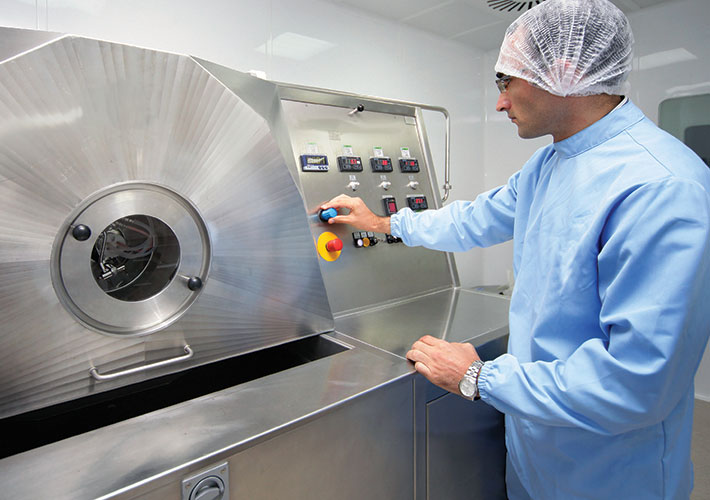
Pharmaceutical Manufacturing Gets Smart
ASTM standards help drug manufacturers improve production processes.
There is no doubt that the evolution of pharmaceutical products continues to improve our quality of life. Much of this owes to advances in medical research, of course, but the ongoing refinement of manufacturing and testing standards also ensures that pharmaceuticals can be produced consistently, cost-effectively and safely.
In 2003, after a major overhaul of U.S. regulations governing drug manufacture, industry stakeholders created ASTM Committee E55 on Manufacture of Pharmaceutical and Biopharmaceutical Products. Their goal was to develop best practices for processes to advance a scientific approach toward improved manufacturing. The standards they have developed - and those underway - are driving innovation in both manufacturing and process control.
Affordability and Functionality
The affordability and reliability of drug manufacturing processes are optimized by increased standardization. As Ferdinando Aspesi, vice president, senior adviser quality group, at Novartis Corp., explains of one of the many standards pioneered by E55, "Standard E2503 has provided cost savings by standardizing the dissolution apparatus and the process to calibrate the paddle and dissolution apparatus. Once a unit meets all the mechanical specifications included in this practice it is considered calibrated, and further calibration with dissolution calibration tablets is not required. Once the apparatus is calibrated, a test with tablets of the product being assessed can be done. Where and when E2503 is adopted, it allows us to get rid of expensive chemical standards and reduce the variability of the data generated with such tests. It has improved quality control laboratory sample testing cycle time, efficiency and data reliability."
Similarly, ASTM standard E2500, a general guide for the design and verification of pharmaceutical manufacturing systems, has "greatly streamlined the qualification and validation of equipment, processes and associated systems." Such standards have also reduced costs, clarified roles and established proactive risk-based approaches. as well as cut down on "duplicating paperwork and simplifying the administration of such activities," says Aspesi.
Single use, disposable, devices for making pharmaceuticals such as vaccines offer a lower risk of contamination, which increases safety and ultimately benefits patients. This increasingly common equipment can be used in products and processes. Standards allow not only for affordability - a savings that is passed on to the consumer - but also a better product. Duncan Low, Ph.D., is responsible for materials science at Amgem and is an expert in single use systems. He says that E55 is "providing a forum for end users and suppliers to develop and advance best practices in pharmaceutical manufacturing." This is especially true "where guidance is required for the characterization and use of new materials and unique assemblies, which require novel approaches for their application and verification, and where suppliers and end users are collaborating more closely than has been the practice in the past."
Health and Safety
Standards also ensure safer pharmaceutical products. In the process of purification, for example, ASTM standards remove or render null any potential retrovirus. By using standards in the manufacturing process, pharmaceutical companies can help protect the consumer while reducing excessive costs such as those associated with viral clearance.
Testing for uniformity is another crucial function of ASTM standards. Like standards associated with purification, testing for uniformity reduces possible consumer risks while avoiding excessive costs and waste. A doctor's ability to fine-tune a patient's prescription depends on the pharmaceutical manufacturer's ability to guarantee the exact dosage contained within each particular capsule. A reputation for an unreliable product would essentially sink any pharmaceutical company as well as open it up to any number of lawsuits.
Manufacturing to Terminology
ASTM standards cover everything from manufacture to testing to storage, helping companies across the board and bringing a certain level of coherence to the processing of pharmaceuticals. Moreover, the development and refinement of terminology is vital for safe and cost-effective production. Creating a common terminology eliminates contradictory standards and creates a safe marketplace.
This sort of commonsense element lays a foundation for other, more complex standards, allowing terms to function unobstructed by confusion, ambiguity or contradiction. In building a complex, layered set of standards, precision terminology allows for highly specific qualifications and distinctions.
For all of these reasons, pharmaceutical standards such as those developed by Committee E55 should be understood as careful, painstaking work that undergirds the research and mass production of life-saving and life-enhancing modern pharmaceuticals. Without the precision that such standards ensure, much of modern medicine could not get outside of the realm of theory, since it could not reliably and affordably deliver the medicines that are now so essential to medical treatments.
Chris DeGroot is a freelance writer based in Philadelphia, Pennsylvania.
 SN Home
SN Home Archive
Archive Advertisers
Advertisers Masthead
Masthead RateCard
RateCard Subscribe
Subscribe Email Editor
Email Editor